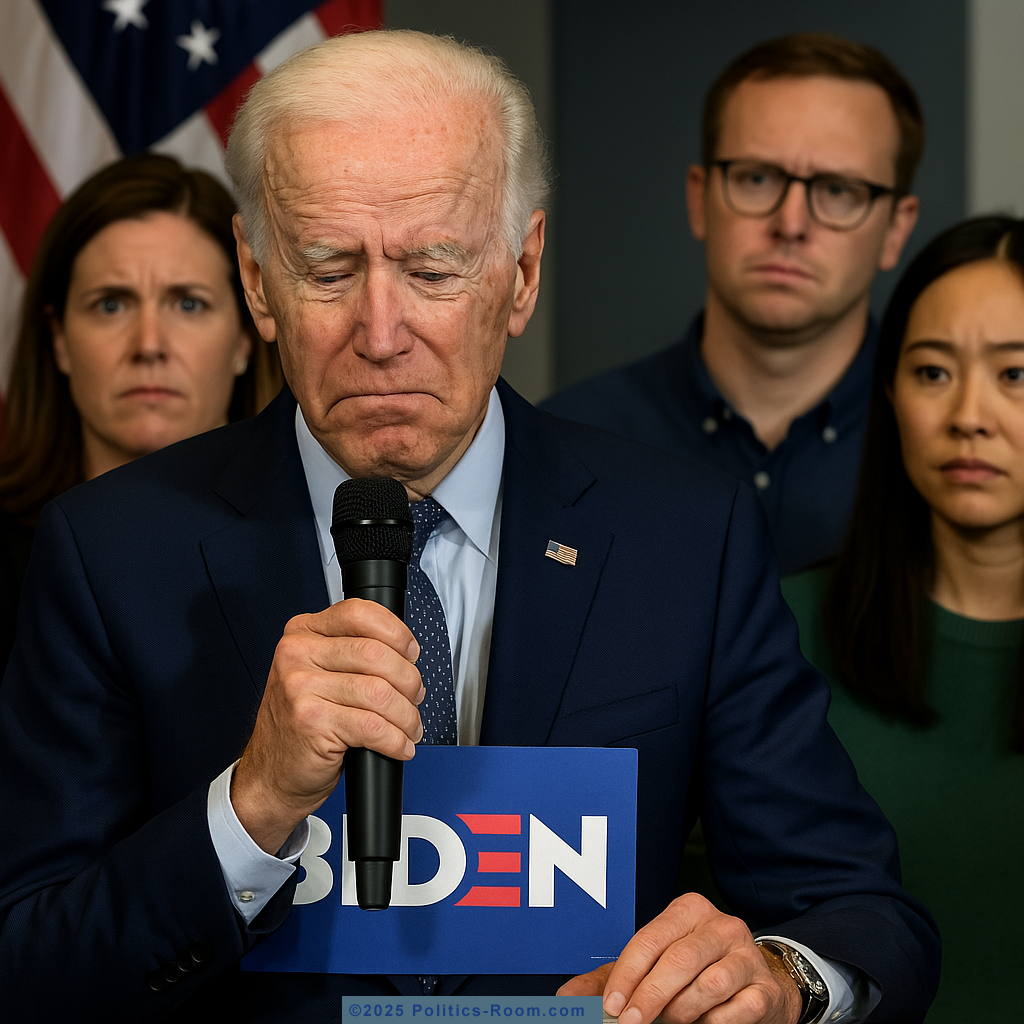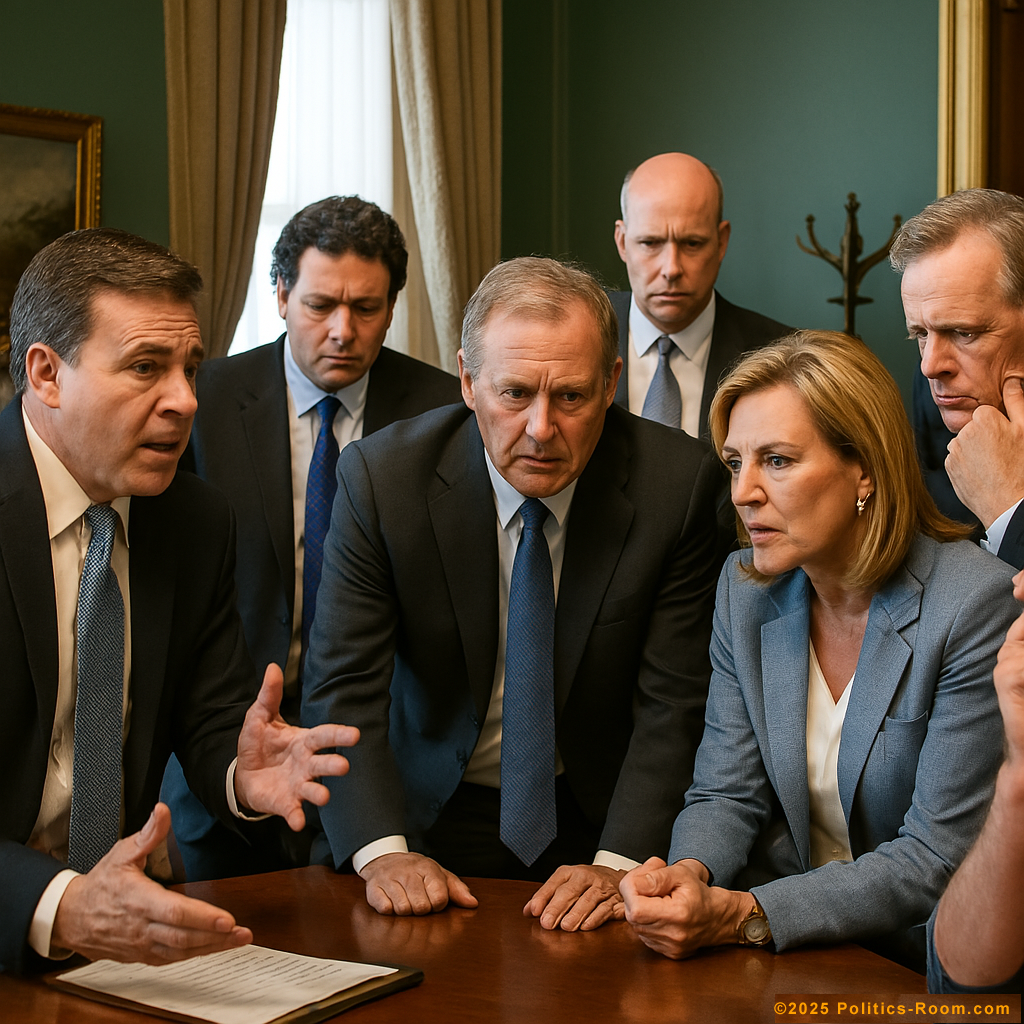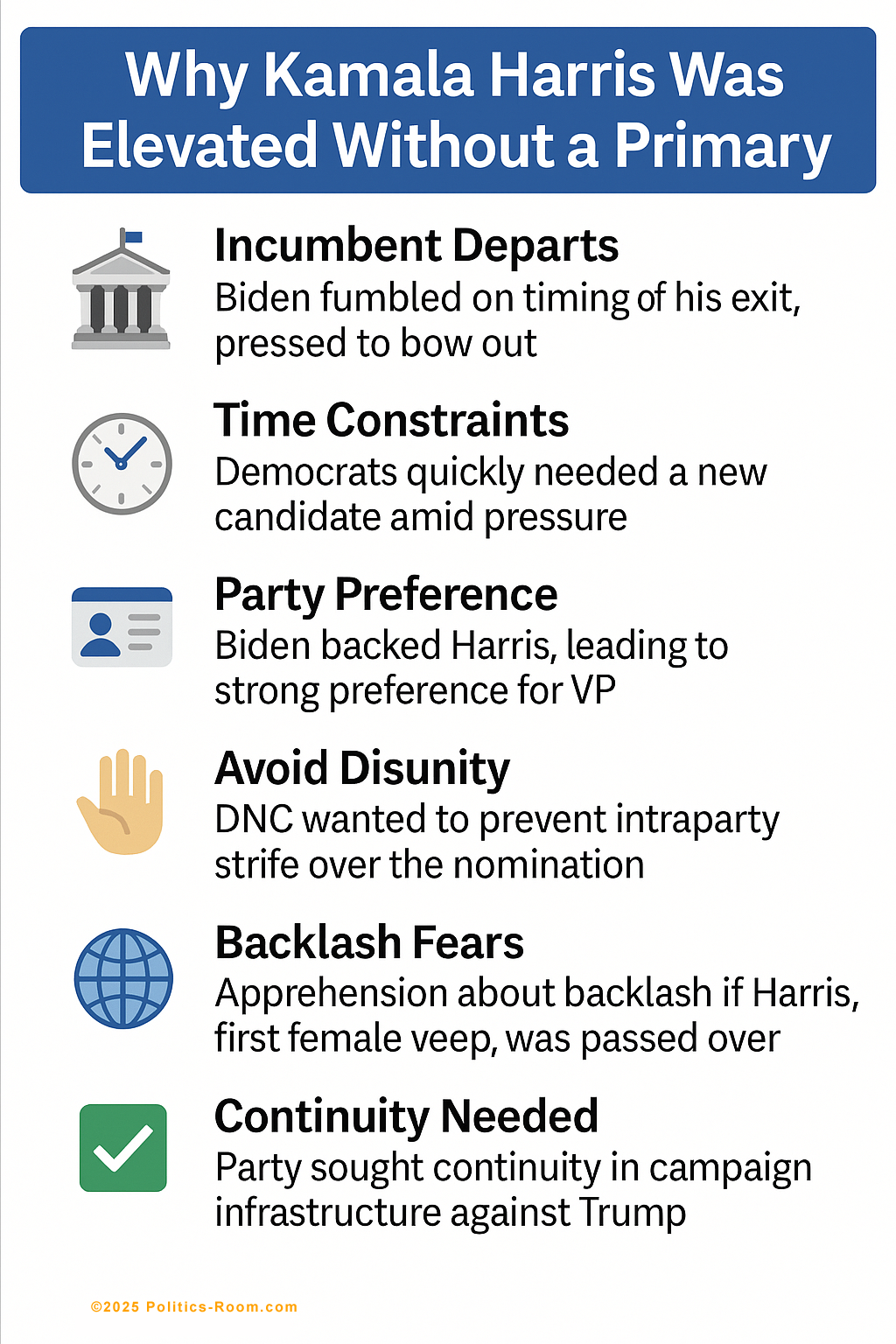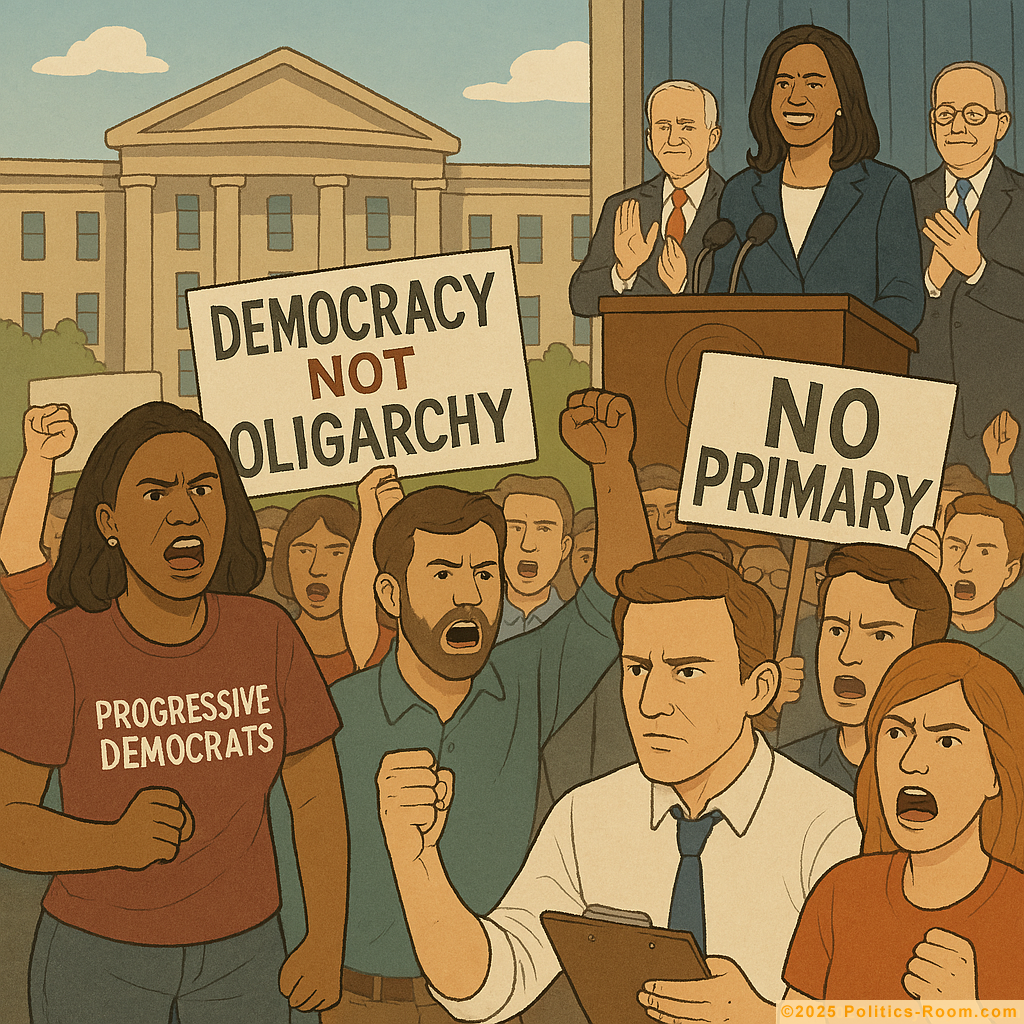📅 Timeline of Events Leading to the Transition
The 2024 election cycle presented unprecedented challenges for the Democratic Party. What began as a relatively straightforward reelection campaign for President Biden transformed into one of the most dramatic succession events in modern American political history. Understanding this transition requires examining the psychological, strategic, and institutional factors that culminated in the abrupt elevation of Vice President Harris without a competitive process.
🧓 Early 2024: Biden's Candidacy Remains Active

- 🗣️ Biden announces reelection run, despite widespread age concerns and declining approval ratings. His team frames the campaign around "finishing the job" and positions him as the only Democrat who had proven he could defeat Donald Trump.
- 🌍 During this period, Biden remains deeply involved in foreign policy crises, particularly European Union and NATO diplomacy regarding Ukraine and other global conflicts. These international commitments appear to take precedence over domestic campaign activities.
- ⏱️ Campaign insiders note that timing for the official campaign rollout and public events becomes increasingly irregular and unclear. Events are scheduled, postponed, and sometimes canceled, creating an impression of disorganization that feeds into Republican narratives about Biden's fitness.
Political psychologists noted a growing disconnect between the administration's messaging about Biden's capabilities and what voters were observing in his public appearances. This cognitive dissonance created an unstable foundation for the campaign, with supporters increasingly required to reconcile conflicting narratives about their candidate.
⚠️ Spring 2024: Mounting Concerns

- 📉 Internal polls begin showing Biden's popularity slipping precipitously, especially among younger and independent voters. Of particular concern, his numbers in crucial swing states drop below levels that would make victory plausible in November.
- 🤕 Concerns about Biden's cognitive sharpness grow as verbal gaffes, missed cues, and long delays in public appearances become more frequent and noticeable. A particularly difficult debate performance catalyzes public discussion about his fitness for another term.
- 📰 Media outlets and Democratic strategists quietly begin discussing potential "exit strategies" for the President, though these conversations remain largely behind closed doors out of respect for Biden and fear of undermining his administration.
This period was characterized by what political scientists call "elite anxiety" – a phenomenon where party leaders and strategists recognize a problem before the general public fully processes it. The resulting tension between public loyalty to Biden and private concerns about his viability created significant psychological strain within Democratic circles.
🎯 June–July 2024: Internal Party Pressure Rises

- 🏛️ Behind closed doors, Democratic governors, major donors, and senior congressional members begin exerting significant pressure on Biden's inner circle to consider having the President step aside. These conversations intensify as polling continues to deteriorate.
- 💰 Major Democratic donors begin pausing contributions or explicitly conditioning their support on leadership changes, signaling a severe lack of confidence in the existing campaign structure and leadership.
- 🇺🇸 Biden initially remains hesitant to step down due to ongoing international negotiations and a personal belief, supported by his closest advisors, that he alone possesses the necessary experience and standing to defeat Trump in a rematch.
This phase represented a classic example of what organizational psychologists call "escalation of commitment" – the tendency to persist with a failing course of action due to previous investment. Biden's team, having committed publicly to his candidacy, found it increasingly difficult to change direction despite mounting evidence that a change was necessary.
💥 August 2024: The Withdrawal

- 🧵 In a move that surprises even some insiders for its timing, Biden announces he will not seek reelection, citing family considerations and the need for party unity. His letter specifically endorses Vice President Harris as his successor.
- ⚖️ The timing of this decision draws immediate criticism as it comes too late for a traditional primary with multiple candidates, given DNC rules, state filing deadlines, and the logistics of ballot access.
- ⏳ Party officials determine that the window is too narrow to organize an open convention or series of regional contests that would allow multiple candidates to compete fairly for the nomination.
This sudden withdrawal created what crisis management experts call a "compressed decision environment" – a situation where normal deliberative processes must be abandoned due to extreme time constraints. The resulting pressure prioritized expediency over procedural inclusivity, with significant consequences for party unity and public perception.
🔄 Why Kamala Harris Was Elevated Without a Primary

The decision to elevate Vice President Harris without a competitive selection process reflected a complex interplay of institutional logic, political expediency, and practical constraints. Several factors made this outcome virtually inevitable once Biden withdrew:
✅ Constitutional Succession Logic
- 👩🏽⚖️ Harris's position as sitting Vice President created a natural succession expectation. The vice presidency is explicitly designed as a backup for the presidency, and this constitutional logic extended to the campaign context.
- 🏛️ Choosing anyone other than Harris could be interpreted as undermining Biden's judgment in selecting her as his running mate in the first place. This would have created a politically damaging narrative of an administration rejecting its own personnel choices.
The institutional momentum of the vice presidency created what political scientists call "path dependence" – a situation where previous decisions constrain current options in ways that make certain outcomes almost inevitable regardless of present circumstances.
🤝 Biden's Endorsement
- 📣 Biden's immediate and emphatic endorsement of Harris as his successor established powerful framing that made it difficult for other potential candidates to challenge the transition without appearing to reject the President himself.
- 🧠 The administration framed the succession as a smooth continuation of the Biden-Harris agenda rather than an opportunity to reconsider the party's direction or leadership, effectively positioning any alternative as a disruption rather than an option.
This endorsement strategy utilized what psychologists call "social proof" – the tendency for people to follow the lead of an authority figure when uncertain about the correct course of action. Biden's status within the party made his preference extraordinarily influential in shaping the response of other leaders.
🗳️ Logistical Constraints
- 🧾 By August, deadlines for ballot access in several states had already passed or were imminent, creating genuine legal barriers to organizing a fair competitive process in the available timeframe.
- 💻 The campaign's digital infrastructure and organizing models were already constructed around the Biden-Harris ticket. Voter databases, fundraising systems, and volunteer networks were integrated with this structure, making a complete reset technically challenging.
These practical constraints exemplify what organization theorists call "structural inertia" – the tendency of established systems to resist fundamental change due to the high costs and risks associated with dismantling and rebuilding complex operational structures.
🕵️♂️ DNC Centralization
- 🏗️ The Democratic National Committee was criticized for rapidly consolidating support behind Harris instead of creating space for even a limited competitive process. Key party officials, fundraisers, and endorsers quickly aligned behind the Vice President.
- 🤖 Critics pointed to this consolidation as evidence of a systemic flaw in the party's internal democracy, suggesting that the process was "managed" rather than genuinely responsive to voter preferences.
- 🧩 The lack of established protocols for an emergency nomination process meant that party leaders defaulted to the most institutionally convenient option rather than creating an ad hoc competitive mechanism.
This centralized decision-making reflected what political scientists call "elite consensus formation" – the tendency for party leadership to coalesce quickly around a single acceptable option in crisis situations, prioritizing stability and unity over diverse input.
❌ Criticisms and Backlash

The manner of Harris's elevation generated significant criticism from various constituencies, revealing deeper tensions within the Democratic coalition and raising questions about the party's commitment to its stated democratic values.
🤯 Party Chaos Perception
- 🧨 The abrupt transition created widespread voter confusion about whether this succession represented a planned transition or a panic response to Biden's declining prospects, undermining confidence in the party's strategic competence.
- 🤔 Many grassroots Democrats expressed frustration that the party moved so quickly to anoint Harris without allowing meaningful input from the broader Democratic electorate, contradicting the party's rhetorical emphasis on participatory democracy.
This perception crisis exemplified what communication theorists call "narrative incoherence" – a situation where the story an organization tells about itself contradicts observable reality, creating cognitive dissonance among its constituents.
🗳️ Concerns About Harris's Electability
- 📊 Harris's approval ratings were also substantially underwater among independents and swing voters, raising questions about whether she represented a significant improvement over Biden in terms of electoral viability.
- 👩🏽⚖️ Critics questioned aspects of Harris's political profile, including her relatively limited executive experience, previous campaign performance, and ability to connect effectively with key voter demographics in contested states.
These concerns reflected what political analysts call the "viability trap" – a situation where party insiders focus so intently on avoiding one electoral liability (in this case, Biden's age and performance issues) that they fail to adequately assess other potential vulnerabilities in their alternative choice.
🪓 Progressive Alienation
- ✊ Progressive leaders and organizations aligned with figures like Alexandria Ocasio-Cortez wanted an open contest that would allow policy debates and potentially elevate a more progressive alternative to both Biden and Harris.
- 🔥 Many progressives interpreted the managed transition as a power play by moderate Democratic establishment figures to maintain control over the party's direction without having to defend centrism in a competitive process.
This alienation demonstrated what political scientists call "factional entrenchment" – the hardening of divisions within a coalition when one subgroup perceives that procedural choices are being manipulated to disadvantage their policy preferences.
✅ Arguments In Favor of the Decision

Despite the criticism, defenders of the Biden-Harris transition offered substantial arguments for why the managed succession represented the best available option under the circumstances:
🔗 Unity Over Chaos
- ⛑️ Avoiding a potentially divisive internal battle for the nomination was seen as crucial to maintaining focus on defeating Trump, especially given the limited time remaining before the general election.
- 🪙 A multi-candidate scramble for the nomination would have splintered the party's financial resources and message discipline at a time when Republicans were already unified and well-funded.
This prioritization reflected what political strategists call "threat hierarchy management" – the pragmatic decision to subordinate internal procedural concerns to the overriding goal of addressing an external threat (in this case, preventing another Trump presidency).
🚀 Momentum Maintenance
- 🔄 Keeping Harris, a familiar face already integrated into the campaign, allowed the Democratic operation to continue functioning without the disruptive reset that selecting an entirely new nominee would have required.
- 📡 This continuity prevented the need for comprehensive rebranding of campaign messaging, visual identity, staffing, and strategy during the critical late-summer period when many voters begin forming their electoral choices.
This approach exemplified what organizational theorists call "adaptive persistence" – making the minimum necessary changes to address a crisis while preserving as much existing infrastructure and momentum as possible.
🎤 Representation & Messaging
- 👩🏽 Harris offered historic representation as potentially the first woman and first person of South Asian and Black heritage to serve as president, creating powerful symbolism that aligned with Democratic commitments to diversity and inclusion.
- 📣 The transition enabled messaging that emphasized generational change and renewal while maintaining policy continuity, addressing Biden's age liability without requiring a wholesale repudiation of the administration's accomplishments.
This messaging strategy utilized what communication experts call "narrative pivoting" – maintaining core story elements while strategically reframing certain aspects to address changing circumstances or emerging weaknesses.
🧩 What Was the Cost?

Even defenders of the transition acknowledge that the managed succession process carried significant costs that may have lasting implications for the Democratic Party and American democracy more broadly:
🧨 Perception of Undemocratic Process
- 🏛️ The lack of voter input into the nomination of a new candidate led many Democrats to feel disenfranchised and marginalized in a process that should, by the party's own values, prioritize grassroots participation.
- 🧱 The controlled transition damaged the party's credibility as the defender of democratic principles at a time when demonstrating commitment to those principles was particularly important in contrast to perceived Republican authoritarianism.
This perception problem illustrates what political ethicists call "procedural hypocrisy costs" – the special damage that occurs when an organization appears to violate the very principles it claims to champion, creating not just disappointment but a sense of betrayal among supporters.
📉 Electoral Fallout
- 🗳️ Voter enthusiasm, particularly among younger and progressive constituencies, measurably declined following the managed transition, potentially affecting turnout in crucial battleground states.
- 💬 Republicans and independents effectively weaponized the succession process as evidence that the Democratic Party is controlled by insiders rather than voters, reinforcing existing skepticism about institutional politics.
These electoral consequences demonstrated what strategists call a "process legitimacy deficit" – the practical disadvantage that occurs when voters question not just a candidate's policies or qualifications, but the very legitimacy of how they came to be the nominee.
🔮 Lessons for the Future

The 2024 Biden-Harris transition revealed significant institutional weaknesses in how American political parties handle succession crises. Several important lessons emerge from this experience that could inform future reforms:
- 🗂️ Emergency succession protocols need to be established in advance, with clear triggers and processes that allow for competitive, abbreviated but legitimate contests when nominees must be replaced late in the cycle.
- 🧭 Parties must develop earlier evaluation mechanisms and honest feedback channels for assessing candidate viability, particularly for elderly candidates where health or cognitive decline risks may increase during a campaign.
- 🧪 The Democratic National Committee should consider restructuring its internal governance to ensure that crisis decisions reflect broader party constituencies rather than concentrating power among a small group of officials and donors.
- 🎤 Political leaders must recognize that in an era of declining institutional trust, procedural fairness and transparency are not merely nice-to-have values but essential components of electoral viability.
These reforms would address what institutional theorists call "crisis resilience gaps" – the vulnerabilities that become apparent only during extraordinary circumstances but require proactive attention during normal periods to prevent future failures.
The 2024 Democratic transition will likely be studied for years as a case study in crisis management, institutional adaptation, and the tensions between pragmatism and principle in democratic politics. Whatever the electoral outcome in November, the process by which the party arrived at its nominee revealed fundamental questions about how American democracy functions in an era of polarization, institutional distrust, and rapid information flow. The answers to these questions will shape not just future campaigns but the very nature of political participation in the United States.










